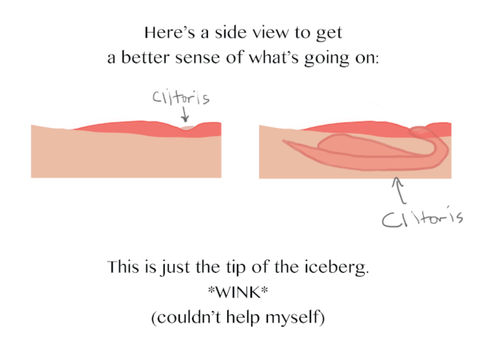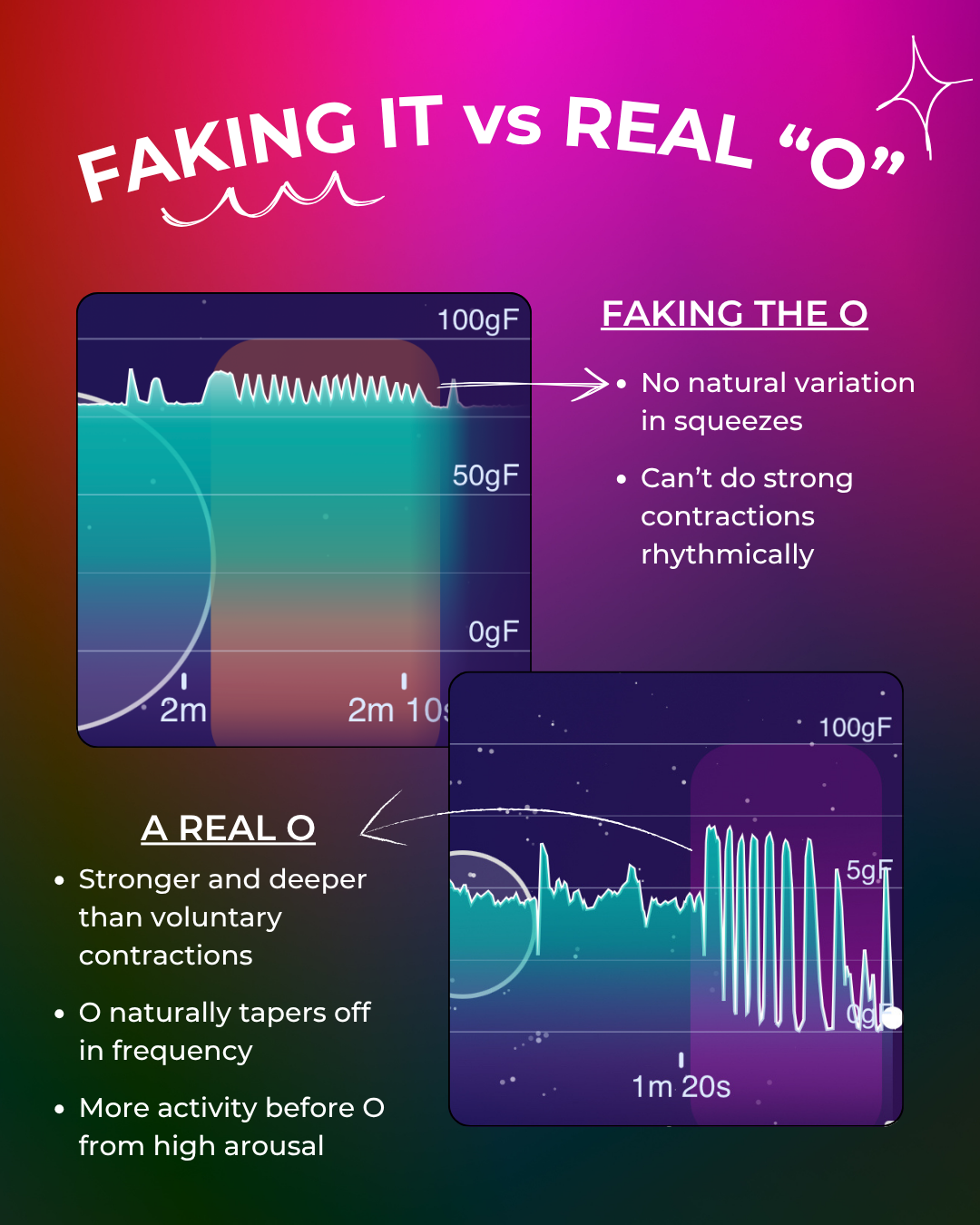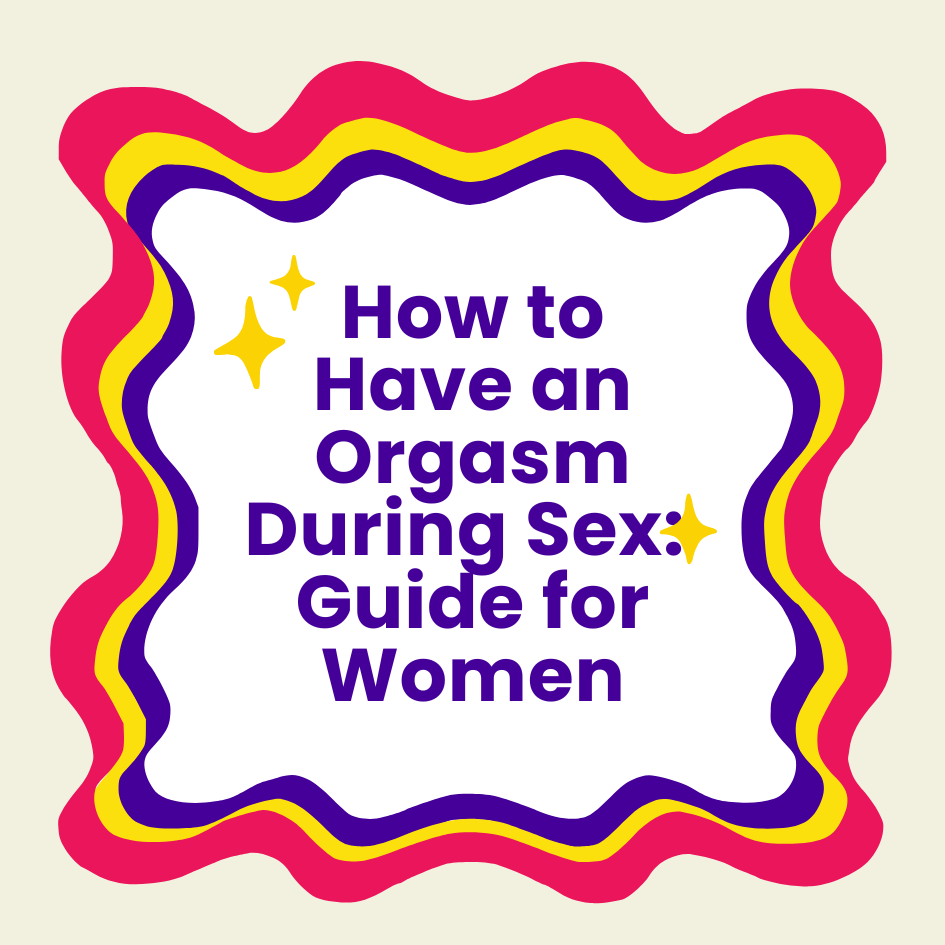
Myth, misunderstanding, and confusion
"What is the clitoris? Where is the clitoris? What do I do with the clit?"
There are few organs as misunderstood as the clitoris, despite its important function in sex for almost all adult women.

The clitoris is the only organ in the human body whose sole purpose is sexual pleasure. [9]
But that fact is exactly why it’s missing-in-action from conventional sexual health education. Even now, sex ed for women is focused mainly around reproduction (baby-making) and gives little to no information about pleasure. Most information beyond that is about how sex gets girls into trouble and how they should watch out / be responsible. [12]
An organ where discussion of pleasure is unavoidable (because it doesn't do anything else) falls outside of that framework — so much so that even popular anatomy textbooks still don’t cover the clitoris and female orgasm. [7]
The clitoris is more than you think it is
Let’s clarify first what the clitoris is. As a term, “vagina” is often used (incorrectly) to describe all of female genitalia—losing clarity and creating confusion around what sub-parts actually exist.
A similar problem exists for “clitoris”—just in the other direction. It’s used to describe a small portion of what it truly is.
You might have noticed that the term “button” appears a lot in slang for “the clit.” This classical "button" is the externally exposed, highly sensitive portion of the clitoris, known as the glans, as seen in the below diagram. [6]

So, what body part does clitoris actually refer to? It may come as a surprise, but most of the blue portion highlighted!
(There's some debate about the vestibular bulbs, especially from an embryological perspective, but that's way beyond the scope of this introduction [10]).
A comic from my cofounder, Liz, makes it clearer. A helpful excerpt is below (the dark pink is the clitoris "x-ray" view within the vagina):
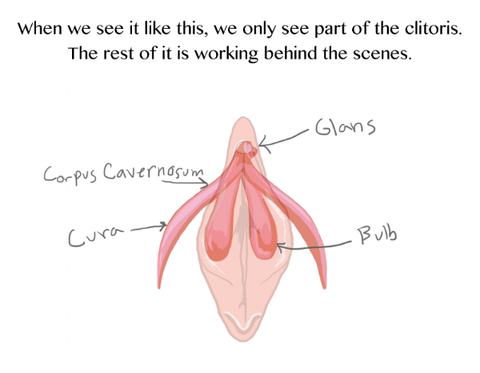
The glamorous glans and the orgasm gap
Of course, there is a reason why the glans is so important—and why we talk about it almost to the exclusion of the rest of the clitoris. It’s the only portion of the clitoris that can be directly touched (since the rest of it is deeply integrated with the vagina), and it is also the most densely innervated. [8]
That dense innervation, and the fantastic sensitivity that results in, is what makes it so important in sexual satisfaction. Many women who can’t achieve orgasm through vaginal penetration alone can orgasm when glans stimulation is incorporated.
The orgasm gap
As one would expect, this fact has a big impact on heterosexual couplings. One widely reported study found that while 75% of heterosexual men had regular orgasms, only 29% of women reported the same. [5]
Can we fix this just with knowledge that the clitoral glans exists?
Another study looked at exactly that. Relative to women who experienced vaginal penetration alone, 50% more women orgasmed when their partner added manual stimulation (touching of the glans). This number went even higher with sex toys and other aids. [11]
This is, by no means, a perfect measure. After all, more adventurous or communicative partners probably try more things and have better sex that has to do with way more factors than just manual stimulation.
However, we can take confidence from the fact that this is fairly in line with other studies that look at the same question with different methods.
Why does it make such a difference?
As mentioned, the clitoris glans is the most sensitive portion of the clitoris, and is neglected in most heterosexual intercourse, to the detriment of the female partner.
If all that happens during sex is penetration, we know (with our newfangled anatomy knowledge) why this happens. The glans isn’t located in the vagina, so it’s not going to be directly stimulated during sex.
This is a fact that 68% of college students actually got wrong. [13]
But wait, it gets even worse!
Wait, why did the diagram say "erectile tissue" above?
The great irony of believing that the clitoris glans is directly stimulated during sex is that not only is that wrong… the glans actually moves away from the penis during penetrative intercourse. [9]


As the above illustrations from The Atlas of Human Anatomyhelpfullydemonstrate, the sensitive clitoris glans, when erect / engorged, moves upwards and away from the vaginal introitus (opening). [1]
Now, dear observant reader, if you thought that sensitivity, erection, and engorgement sound an awful lot like what happens to the penis during arousal, you’re right! That’s not a coincidence.
"The Female Penis"
Before diving further into this topic, it’s worth pointing out that there’s been some pretty unfortunate history in comparing the clitoris (glans) with the penis.
Specifically, there is a long tradition in Freudian psychology of claiming that the the clitoris is a micro-penis that women would “get over” getting off on… when they finally matured into full women who enjoy vaginal orgasms vs. clitoral orgasms. [2]
If that sounds like something a misogynist would make up, that’s because that’s more or less exactly what happened (I go into much more detail on this in the linked article above).
Actual science
That being said, his idea of the clitoris being related to the penis didn't come from nowhere—even if he took into a crazy direction. It does have origins from more respectable (i.e. actual) science.

 In fetal development, the clitoris (the whole thing) and penis originate from the same set of cells. [9] Is it a female penis? Well, as much as the penis is a male clitoris. Both are composed of sensitive erectile tissue and have critical roles in sexual arousal and pleasure.
In fetal development, the clitoris (the whole thing) and penis originate from the same set of cells. [9] Is it a female penis? Well, as much as the penis is a male clitoris. Both are composed of sensitive erectile tissue and have critical roles in sexual arousal and pleasure.
For some of our male readers, this can serve as a point of comparison: what if someone expected you to orgasm without ever stimulating your penis (especially the glans, the head of the penis… which doesn’t just have the same name by coincidence)?
(Side note for attentive readers: yes, the clitoris's "bulbs" aren't included here—certain embryologists are fairly zealous that they aren't part of the clitoris... and others are just as insistent that they are.)
All about that glans?
With everything we've said, it's easy to think that the clitoris glans is the end-all, be-all solution to everything related to female sexuality.
Unfortunately (or fortunately?), it's not. I did mention there'd come a time where it's important to remember the glans is not the entire thing.
Some women need clitoral glans stimulation to orgasm—but others prefer internal vaginal stimulation or a combination of the two. While it's important to emphasize that glans stimulation is valid, given history (thanks, Freud), we should be careful not to invalidate others' sexual experiences.
(This topic is closely related to my article on vaginal vs. clitoral orgasms, and article on what is the g-spot... each of which give 1000+ word treatments of these topics.)
Scrabble gone wrong
I cover this more in the other articles, but there's a lot of debate on whether or not the vagina can be meaningfully separated from the clitoris.
In this debate, many awkward terminologies have emerged. The clitoro-urethro-vaginal complex, "clitoral complex", clitoris-urethro-vaginal (CUV) complex... and more! [3, 10]
(You're welcome for your next Scrabble game.)
Sexuality is complicated
However, the core point here is the vagina and the clitoris are highly interconnected—and it's hard to differentiate what's being stimulated.
To our best knowledge, both contribute to sexual pleasure.


The clitoris and vagina have nerves that run commonly through both, and similar places light up in the brain when touched. [8, 4]
So, what's the takeaway of all this?
There's a lot of places that could feel really good. And while you should definitely know about and explore the clitoris glans if you haven't—don't neglect the rest of it (clitoris, CUV, or otherwise) with your newfound knowledge.
Self-experimentation is key to pleasure
We have a fairly consistent rallying cry here at Lioness to self-experiment. It certainly makes sense in light of our product whose entire purpose is to aid in doing so... but causally speaking, we didn't promote this notion after we created the product—we created the product because this notion is so important.
Case in point: that study I cited about college students is pretty interesting. It didn't just ask about whether the clitoris is directly stimulated during sex—it quizzed students about all sorts of aspects of clitoral anatomy, and asked them where they learned about it.
Sources of knowledge
Fascinatingly, learning about the clitoris from friends and family was negatively associated with having correct information. Porn didn't help at all. Non-pornographic media, books, and sexual partners helped...
But nothing came even close to self-exploration to having the right answers—self-explorers had double the rate of accuracy, all else equal.

The kicker
Now, here's the kicker. It also asked about frequency of orgasms (it's a great study). Well, knowledge (correct answers) was highly correlated with frequency of orgasms among women—and guess who had the most? Yup, the self-explorers. [13]
Admittedly, it's much less of a difference in partnered sex (vs. masturbation), but that shouldn’t be too surprising. It takes two to tango. And, continuing that analogy, both people have to know how to do so in order to not look silly.
And what does that tell us?
Well, it seems like we should spread this information far and wide (which is why I wrote this)... and do more self-exploring!
If nothing else, I expect the latter is a lot of fun.
===
Want to get started self-exploring (... or if you're confused what I was referring to before)? Find out more about The Lioness here!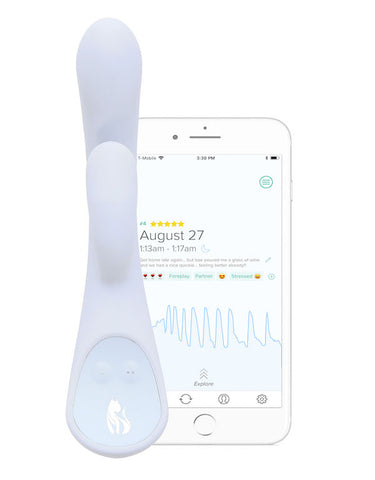 Lioness is the first and only vibrator that helps you improve your orgasms.
Lioness is the first and only vibrator that helps you improve your orgasms.
The world’s most advanced rabbit-style vibrator. Precision sensors let you literally see your arousal and orgasm. Experiment, understand yourself, and have better orgasms — after all, as the saying goes, “never measured, never improved.”
Click here to learn more.
===
References
[1] Atlas of Human Anatomy, Descriptive and Regional. Volume I, Osteology, Arthrology, Myology. M. W. Woerdman, Professor of Anatomy, University of Amsterdam. Williams and Wilkins, Baltimore. (2005). http://doi.org/10.1002/ar.1091030308
[2] Freud, S., & Young-Bruehl, E. (1992). Freud on Women. W. W. Norton & Company.
[3] Jannini, E. A., Buisson, O., & Rubio-Casillas, A. (2014). Beyond the G-spot: clitourethrovaginal complex anatomy in female orgasm. Nature Publishing Group, 1–8. http://doi.org/10.1038/nrurol.2014.193
[4] Komisaruk, B. R., Wise, N., Frangos, E., Liu, W. C., Allen, K., & Brody, S. (2011). Women's Clitoris, Vagina, and Cervix Mapped on the Sensory Cortex: fMRI Evidence. The Journal of Sexual Medicine, 8(10), 2822–2830. http://doi.org/10.1111/j.1743-6109.2011.02388.x
[5] Laumann, E. O. (1994). The social organization of sexuality : sexual practices in the United States. Chicago : University of Chicago Press.
[6] O'CONNELL, H. E., Eizenberg, N., Rahman, M., & Cleeve, J. (2008). The Anatomy of the Distal Vagina: Towards Unity. The Journal of Sexual Medicine, 5(8), 1883–1891. http://doi.org/10.1111/j.1743-6109.2008.00875.x
[7] O'CONNELL, H. E., SANJEEVAN, K. V., & HUTSON, J. M. (2005). ANATOMY OF THE CLITORIS. The Journal of Urology, 174(4), 1189–1195. http://doi.org/10.1097/01.ju.0000173639.38898.cd
[8] Pauls, R. N. (2015). Anatomy of the clitoris and the female sexual response. Clinical Anatomy, 28(3), 376–384. http://doi.org/10.1002/ca.22524
[9] Puppo, V. (2013). Anatomy and physiology of the clitoris, vestibular bulbs, and labia minora with a review of the female orgasm and the prevention of female sexual dysfunction. Clinical Anatomy, 26(1), 134–152. http://doi.org/10.1002/ca.22177
[10] Puppo, V., & Puppo, G. (2015). Anatomy of sex: Revision of the new anatomical terms used for the clitoris and the female orgasm by sexologists. Clinical Anatomy, 28(3), 293–304. http://doi.org/10.1002/ca.22471
[11] Richters, J., de Visser, R., Rissel, C., & Smith, A. (2006). Sexual practices at last heterosexual encounter and occurrence of orgasm in a national survey. Journal of Sex Research, 43(3), 217–226. http://doi.org/10.1080/00224490609552320
[12] TOLMAN, D. L. (1994). DOING DESIRE. Gender & Society, 8(3), 324–342. http://doi.org/10.1177/089124394008003003
[13] Wade, L. D., Kremer, E. C., & Brown, J. (2005). The Incidental Orgasm: The Presence of Clitoral Knowledge and the Absence of Orgasm for Women. Women & Health, 42(1), 117–138. http://doi.org/10.1300/j013v42n01_07

